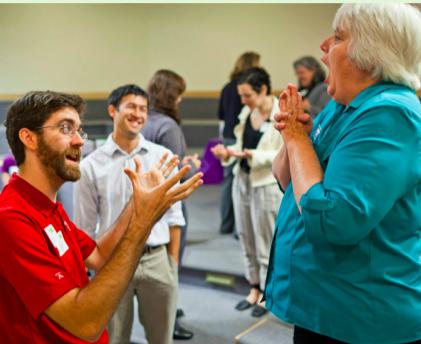DESCRIPTION
Improv exercises empower educators to facilitate positive, learning conversations with visitors. Incorporating improv exercises into staff and volunteer training helps create a supportive and upbeat environment for educators to practice and strengthen essential skills. Included are tips on how to lead improv exercises with your staff and guides for 13 separate improv activities you can use.
DESCRIPTION
Improv exercises empower educators to facilitate positive, learning conversations with visitors. Incorporating improv exercises into staff and volunteer training helps create a supportive and upbeat environment for educators to practice and strengthen essential skills. Included are tips on how to lead improv exercises with your staff and guides for 13 separate improv activities you can use.
OBJECTIVES
BIG IDEA
Improv exercises can strengthen skills educators use when interacting with guests.
LEARNING GOALS
Prepare staff to hold learning conversations with guests rather than reciting scripts.
Warm up critical skill sets required for guest interaction/guest facilitation.
Empower staff to think on their feet and respond in the moment.
NANO CONTENT MAP
Nanometer-sized things are very small, and often behave differently than larger things do.
Scientists and engineers have formed the interdisciplinary field of nanotechnology by investigating properties and manipulating matter at the nanoscale.
Nanoscience, nanotechnology, and nanoengineering lead to new knowledge and innovations that weren't possible before.
Nanotechnologies—and their costs, utility, risks, and benefits—are closely interconnected with society and with our values.
DOWNLOAD FILES
- Leading Improv Exercises (DOC)
- Alien Scientist Improv Guide (DOC)
- Beat NISE Improv Guide (DOC)
- Clap Around Improv Guide (DOC)
- I Say Hi Improv Guide (DOC)
- Name and Gesture Improv Guide (DOC)
- Positive Conversations Improv Guide (DOC)
- Questions Improv Guide (DOC)
- Red Ball Improv Guide (DOC)
- Self Assembly 500 Improv Guide (DOC)
- Thank You Improv Guide (DOC)
- Water Water Improv Guide (DOC)
- What Are You Doing Improv Guide (DOC)
- What's in the Box Improv Guide (DOC)
Credits
Multiple owners including: Museum of Science & Industry, Chicago; Sciencenter, Ithaca, NY; Science Museum of Minnesota
Developed for the NISE Network with funding from the National Science Foundation under Award Numbers 0532536 and 0940143. Any opinions, findings, and conclusions or recommendations expressed in this product are those of the authors and do not necessarily reflect the views of the Foundation.
Creative Commons Attribution Non-Commercial Share Alike 3.0 United States (CC BY-NC-SA 3.0 US).
View more details

NISE Network products are developed through an iterative collaborative process that includes scientific review, peer review, and visitor evaluation in accordance with an inclusive audiences approach. Products are designed to be easily edited and adapted for different audiences under a Creative Commons Attribution Non-Commercial Share Alike license. To learn more, visit our Development Process page.

